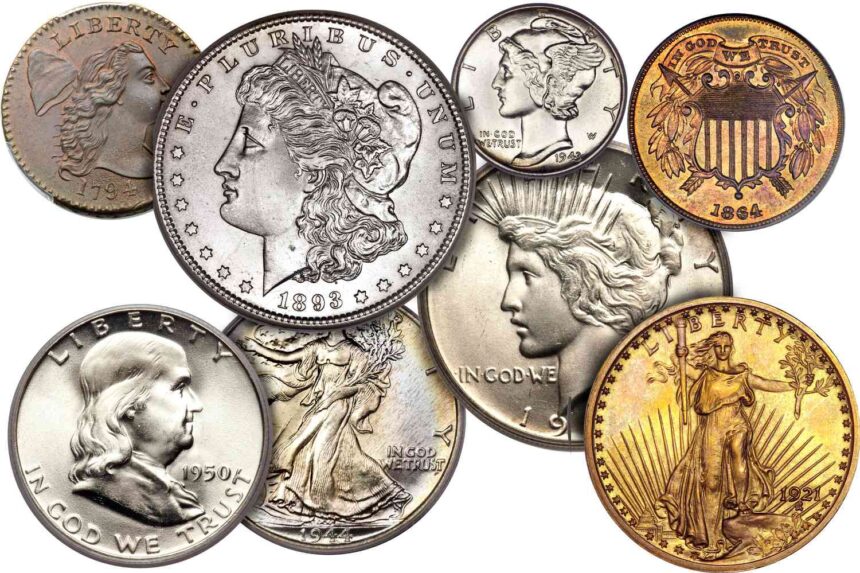Investing in rare dimes can be a rewarding venture, combining the passion for numismatics with the potential for financial gain. Over the years, certain dimes have proven to be sound investments due to their historical significance, rarity, and increasing demand among collectors. This article will explore current market trends, offer investment tips, and provide insights into the world of rare dime investing.
Trends in Rare Dime Investing

- Rising Demand for Key Dates: Coins like the 1916-D Mercury Dime and the 1894-S Barber Dime have seen consistent demand due to their low mintage and historical importance. Key dates often appreciate in value as they become harder to find in higher grades.
- Popularity of High-Grade Coins: Coins in mint state or with desirable attributes like Full Bands (FB) on Mercury Dimes command premium prices. The market increasingly favors well-preserved specimens.
- Interest in Varieties and Errors: Unique varieties, such as overdates (e.g., 1942/1 Mercury Dime) and mint errors, are gaining popularity. Collectors and investors alike value these coins for their rarity and uniqueness.
- Emergence of Online Marketplaces: Platforms like eBay and dedicated numismatic auction sites have expanded access to rare dimes, allowing collectors to buy and sell with greater ease. This has increased market liquidity and visibility.
- Graded Coins as Investment Vehicles: Coins graded by reputable services like the Professional Coin Grading Service (PCGS) or the Numismatic Guaranty Corporation (NGC) are preferred by investors. The certification provides assurance of authenticity and condition, which is critical for investment-grade coins.
Tips for Investing in Rare Dimes

- Research and Education: Before investing, educate yourself about different series, key dates, and the nuances of coin grading. Knowledge is essential to making informed decisions.
- Buy Quality, Not Quantity: Focus on acquiring a few high-quality coins rather than many lower-grade specimens. High-grade coins tend to appreciate more and are easier to sell.
- Verify Authenticity: Purchase coins that have been authenticated and graded by reputable third-party services. This minimizes the risk of buying counterfeits or altered coins.
- Stay Informed on Market Trends: Follow numismatic publications, forums, and market reports to stay updated on current trends and price movements. This can help you identify buying and selling opportunities.
- Diversify Your Collection: While focusing on rare dimes, consider diversifying within the series or into other valuable coins. This spreads risk and increases the potential for overall gains.
- Network with Other Collectors and Dealers: Building relationships within the numismatic community can provide valuable insights and access to exclusive buying opportunities.

Market Insights
Historical Performance: Rare dimes have shown strong historical performance, with many key dates appreciating significantly over time. The 1916-D Mercury Dime, for instance, has seen substantial value increases, especially in higher grades.
Current Market Conditions: The rare coin market remains robust, with continued interest from both collectors and investors. Economic uncertainties often drive interest in tangible assets like rare coins, which can serve as a hedge against inflation and market volatility.
Future Outlook: The long-term outlook for rare dimes is positive, given their limited supply and growing collector base. As more people turn to numismatics as a hobby and investment, demand for rare dimes is expected to remain strong.
Conclusion:
Investing in rare dimes is an exciting and potentially profitable venture. By understanding market trends, focusing on quality coins, and staying informed, you can build a valuable collection that appreciates over time. Whether you are a seasoned investor or new to numismatics, rare dimes offer a unique blend of historical significance and investment potential.
Frequently Asked Questions (FAQ)
Q1: What makes a dime “rare”?
A: A dime is considered rare based on its low mintage, historical significance, condition, and any unique characteristics such as errors or varieties.
Q2: How can I determine the value of a rare dime?
A: The value is determined by factors such as date, mint mark, condition, and current market demand. Professional grading services and price guides can provide accurate valuations.
Q3: Is it better to invest in graded or ungraded dimes?
A: Graded dimes are generally preferred for investment because their condition and authenticity are verified, reducing the risk of buying counterfeits.
Q4: Where can I buy rare dimes for investment?
A: Reputable coin dealers, numismatic auctions, and online marketplaces are good sources. Ensure you buy from trusted sellers and consider coins graded by PCGS or NGC.
Q5: Can rare dimes be part of a diversified investment portfolio?
A: Yes, rare dimes can complement traditional investments like stocks and bonds, offering diversification and potential protection against economic downturns.






